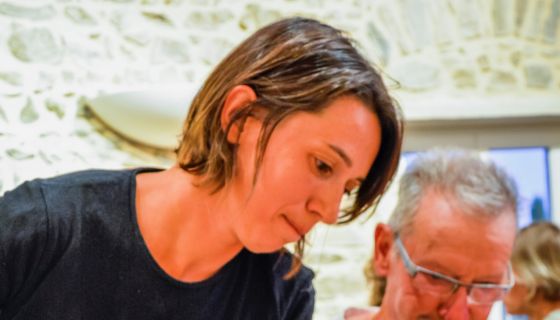From £10.50 (or £39 per case of 6 in bond, until the end of February), €12, $15.95
Unlike most of the red burgundies from the 2018 vintage tasted during Burgundy Week in London earlier this month, Pauline Passot’s four wines from Beaujolais that I tasted were already bottled and are therefore already shipped and available.
And unlike many of the wines tasted during Burgundy Week, they are very good value for money. The Domaine de la Grosse Pierre 2018 Chiroubles is ready for drinking now if you want to enjoy its pure, juicy primary cherry and blackberry fruit but you could also keep it for a few years while the tannins, which are already fine, become even more silky. While this fresh ripe fruit is to the fore, the wine finishes with a more savoury, slightly darker flavour, adding another dimension.
The more expensive Domaine Pauline Passot, Grille-Midi 2018 Chiroubles, sold under her own name, is still excellent value for money and is a more ‘serious’ cru beaujolais, part aged in big old oak (600-litre demi-muids that are 7–10 years old), with darker fruit, a much more savoury character and dry-textured finesse – and slightly longer ageing potential, though there is really no need to wait. However, she makes only 3,000 bottles of this wine so it is harder to find. It is currently available from Howard Ripley at £18.30 per bottle (or £78 per six bottles in bond).
The vineyards, mostly in Chiroubles, one of Beaujolais' 10 named crus or top subregions, are organic or in the process of conversion and all her wines are made using whole bunches and semi-carbonic maceration, with no added yeast, no added sulphur dioxide apart from a little at bottling, and extremely gentle extraction. The wines are aged 8–11 months in concrete tanks, with only the Grille-Midi subject to a very light oak influence. They show real purity, a sensitive touch and freshness, with fruit that has benefited from the ripeness of 2018, yet they are far from simple – just the sort of wines I would be extremely happy to find in a wine bar or restaurant, or on my table at home. As I wrote in my note on her Fleurie: wines 'for those who appreciate subtlety rather than mass'.
Passot’s route into winemaking was indirect even though she now makes wines from the vineyards that belong to her family's domaine. This picture shows her grandfather's Grille-Midi vineyard in the foreground and the Domaine de la Grosse Pierre in the distance.
She studied business, worked in a wine bar in Dublin and then as a sommelier at Pierre Orsi restaurant in Lyon until 2013. After vintages in New Zealand and Chile, the siren call of Beaujolais and Gamay proved too strong and she came back to the region to study in Beaune before making the first wine under her own name – Domaine Pauline Passot, Grille-Midi 2016 Chiroubles – from less than 1 ha (2.5 acres) of vines that belonged to her grandfather.
In 2018 she took over winemaking at the family estate, Domaine de la Grosse Pierre in Chiroubles. Total production is now around 40,000 bottles a year and the straight Chiroubles is her biggest cuvée (20,000 bottles).
I have focused here on the basic Chiroubles because it is excellent value for money and the most widely available of Pauline Passot’s wines. But I would also recommend the other 2018s I tasted recently: Chiroubles Aux Craz (from a single parcel of vines, her highest, at 480 m/1,575 ft) and Fleurie Bel Air.
In the UK the Chiroubles is available from Howard Ripley and Haynes, Hanson & Clark. Peter Weygandt is the US importer, and according to Wine-Searcher it is available from several retailers in New York. It is also to be found in France and the Netherlands.















